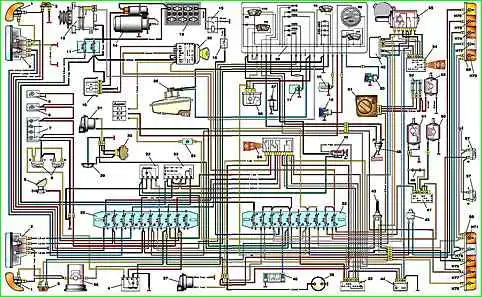Electrical equipment failures are often explained by simple reasons, such as corrosion of connector contacts, failure of a fuse, burnt-out fuse link or damaged relay
Visually check the condition of all fuses, wiring and connectors on the circuit before proceeding with a more detailed check of the serviceability of its components.

Electrical equipment of GAZ-3302 and GAZ-2705 vehicles with engines and the ZMZ-406 family: 1 - direction indicator; 2 - headlight; 3 - turn signal repeater; 4 - switch for lamps for lighting the rear seats of the cab (vehicles with two rows of seats); 5 - engine compartment lamp; 6 - courtesy light for the rear seats of the cab (for vehicles with two rows of seats); 7 - interior lighting (front seats) of the cabin; 8, 9 - lampshades for lighting the cargo compartment (GAZ-2705 with two rows of seats); 10 - starter relay; 11 - fuse box in the engine compartment; 12 - generator; 13 - battery; 14 - starter; 15 - battery switch; 16 - remote battery switch button; 17 - coolant overheat warning lamp sensor; 18 - coolant temperature indicator sensor; 19 - oil pressure indicator sensor; 20 - warning lamp sensor for emergency drop in oil pressure; 21 - diagnostic block; 22 - switch for (rear) fog light lamps; 23 - central light switch; 24 - diagnostic indicator lamp; 25 - lower fuse block; 26 - windshield washer motor; 27 - sound signal; 28 - portable lamp socket; 29 - canopy lighting of the onboard platform (GAZ-33021); 30 - driver signal switch; 31 – driver signal buzzer (GAZ-33021); 32 - alarm switch; 33 - upper fuse block; 34 - direction indicator switch; 35 - ignition switch (lock); 36 - warning lamp sensor for emergency drop in brake fluid level; 37 - parking brake warning lamp switch; 38 – parking brake warning lamp breaker; 39 - instrument cluster (P3 - tachometer; P5 - voltmeter; P6 - coolant temperature indicator; P7 - oil pressure indicator; P8 - fuel level indicator in the tank; H7 - warning light for emergency drop in oil pressure; H8 - warning light for coolant overheating ; H16 - indicator light for direction indicators; H19 - indicator light for minimum fuel reserve in the tank; H20 - indicator light for high beam headlights; H54 - indicator light for generator malfunction; H56 - indicator light for emergency drop in brake fluid level; H59 - indicator light for turning on the side light ; N 66-N 69 – instrument illumination lamp); 40 - windshield wiper control relay; 41 - heater fan motor switch; 42 - cigarette lighter; 43 - brake signal switch; 44 - turn signal switch; 45 - reverse light switch; 46 - fuel level indicator sensor in the tank; 47 - switch for the electric motor of the additional heater and the electric pump of the heating system (GAZ-2705 with two rows of seats); 48 - radio receiver; 49 - resistor of the electric motor of the additional heater (GAZ-2705 with two rows of seats); 50 - electric pump for the heating system (GAZ-2705 with two rows of seats); 51 - electric motor of an additional heater (GAZ-2705 with two rows of seats); 52 - heater motor resistor; 53 - electric motor (fan) of the heater; 54 - wiper switch; 55 – windshield wiper motor; 56 - rear right light (H70 - fog light lamp; H72 - reverse light lamp; H74 - brake signal lamp; H76 - side light lamp; H78 - turn signal lamp); 57 - license plate light; 58 - left rear light (H71 - fog light lamp; H73 - reverse light lamp; H75 - brake signal lamp; H77 - side light lamp; H79 - turn signal lamp); 59 - fog light lamp (GAZ-2705); 60 - ignition coils; 61 - ignition control unit; 62 - absolute pressure sensor; 63 - engine control system coolant temperature sensor; 64 - knock sensor; 65 - synchronization sensor; 66 - electromagnetic valve EPHH; 67 - fuse (ignition system); 68 - spark plugs
When using diagnostic tools for troubleshooting, carefully plan (in accordance with the supplied electrical diagrams) at which points in the circuit and in what sequence the device should be connected for the most effective fault phenomena.
The main diagnostic instruments include an electrical circuit tester or voltmeter (you can also use a 12-volt test lamp with a set of connecting wires), an open circuit indicator (probe), which includes the lamp's own power source and a set of connecting wires.
In addition, you should always have in your car a set of wires for starting the engine from an external power source (the battery of another car), equipped with alligator clips.
As already mentioned, before you start checking the circuit using diagnostic equipment, determine the location of its connection using the diagrams.





